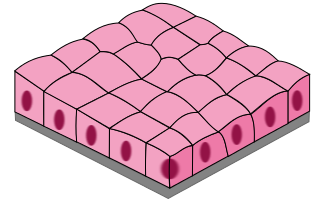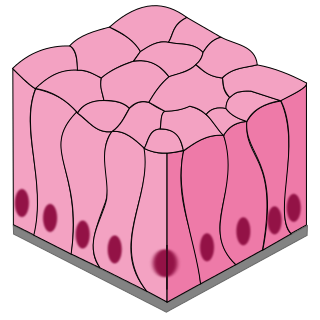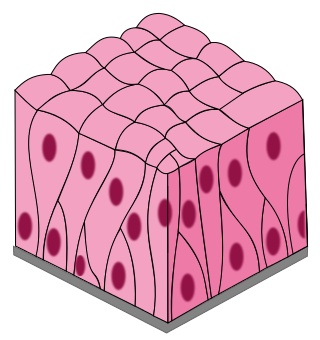The surface of our body and internal organs is subjected to wear, tear and injury. To protect the inner tissues, the outer lining of the body is covered by a specialized group of cells called epithelium.
Epithelial tissues can contain a single layer of cells (Simple Epithelium) or many layers(Stratified Epithelium). In Simple Epithelial Tissues, the cells of the tissue are arranged in a single layer. The cells are rests on a non-cellular basement membrane which is composed of a network of collagen fibres.
Types of Simple Epithelium
Simple Squamous Epithilium

This tissue consists of thin flat, tile like polygonal or hexagonal cells with a centrally located oval or spherical nucleus. Each cell has irregular boundaries. The cells are arranged like tiles on a floor, so, it is also known as pavement epithelium.
Location - It lines the heart,alveoli, bowmans capsule, visceral and peritoneal lining of coelom.
Function - It helps in protection, filtration, absorption and secrection.
Simple Cuboidal Epithelium

This tissue consists of a single layer of cubiodal cells with equal heights, width and spherical nucleus. The cuboid epithelial cell covers the surface of the ovaries and lines the inner surfaces of the cornea. This tissue forms the kidney tubules and contains microvilli.
Location- It lies in the surface of ovaries, lens of eye and inner surface of cornea, thyroid vesicles, salivary gland and pancreatic ducts.
Function- It helps in protection, secretion, absorption and excretion.
Simple Columnar Epithelium

This tissue consists of tall and columnar cells with height exceeding width. Nuclei are elongated and situated in the basal part. This tissue also consists of goblet cells which secrete mucus and protects the lining and lubricates the passage.
Location- It lines the stomach, small and large intestine, digestive glands, ureter, uterine wall and gall bladder.
Function- This tissue helps in secretion excretion and absorption.
Pseudo-stratified Epithelium

This tissue consists of tall, elongated columnar cells. Tips of columnar cells consists cilia. Between the columnar cells, there are smaller cells which do not possess the ciliated structure. Each cell contain oval shaped nucleus.
Location - This tissue is found in lining of trachea, bronchi, nasal chamber, etc.
Function - Mucus traps the bacteria and dust particles.
Comparison of Different Simple Epithelial Tissues
| Location | Cells | Nuclei | Functions | |
|---|---|---|---|---|
|
Squamous |
lining of heart, serosae, blood vessels |
single, scale-like layer |
flattened, centrally located |
diffusion, lubrication |
|
Cuboidal |
kidney tubules, ducts and secretary portions of small glands, and ovary surface |
single, square-like layer |
centrally located, spherical |
absorption, secretion, protection |
|
Columnar |
Ciliated: small bronchi, uterine tubes, and some regions of the uterus Non ciliated: digestive tract and gallbladder |
tall, single-layered |
basally located, elongated |
absorption, secretion, protection (may bear cilli and may contain goblet cells with microvilli) |
|
PseudoStratified |
Ciliated: trachea Non ciliated: sperm ducts |
differ in height, not all cells reach the apical surface |
at various positions |
absorption, secretion, transportation |